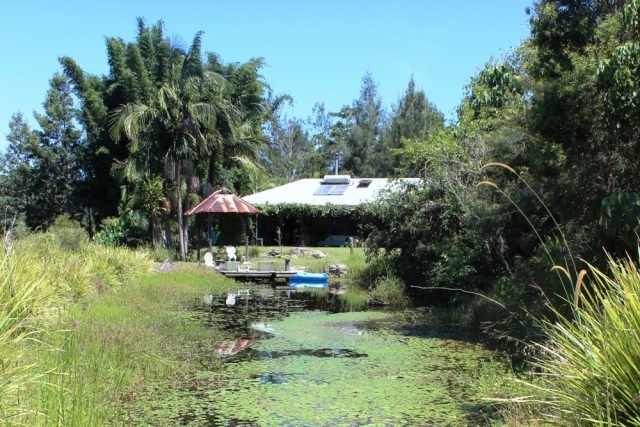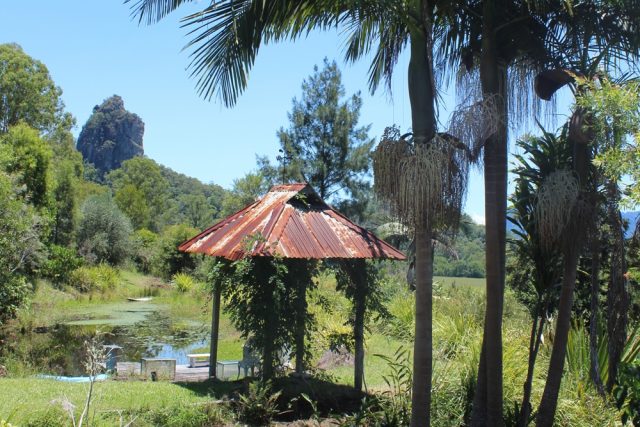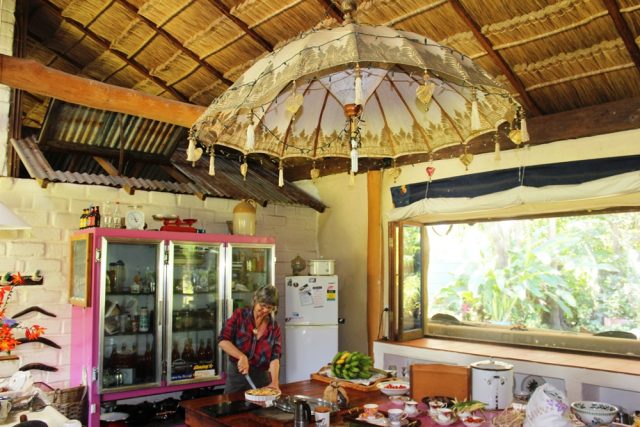 Just before Christmas 2015, I was approached by the producer of a popular British television program, which documents the lives of ex-pat Brits living abroad in wild places, to search the backblocks of the Northern Rivers to find folk from ‘Ol Blighty’ now living amongst us, and more importantly- living “off the grid!” Considering I had what seemed half of Mullumbimby searching ‘hi and low’ for the genuine article, it wouldn’t be such an easy task. I did find interesting people doing just that, living sustainably in the bush, but they were too shy to partake in the adventure. I also had those willing to pretend that their marriage was still intact, shifting back into their old life and abodes together for the chance to be seen around the globe on TV, but I knew scandals would attach themselves to such a debacle. So, I shifted my focus from Byron Shire to the steamy west, around Nimbin. In the end it was the Rainbow Power Company in Nimbin who came to my rescue, and with their advice I found a couple of families willing to spill the beans on their Antipodeans existences.
Just before Christmas 2015, I was approached by the producer of a popular British television program, which documents the lives of ex-pat Brits living abroad in wild places, to search the backblocks of the Northern Rivers to find folk from ‘Ol Blighty’ now living amongst us, and more importantly- living “off the grid!” Considering I had what seemed half of Mullumbimby searching ‘hi and low’ for the genuine article, it wouldn’t be such an easy task. I did find interesting people doing just that, living sustainably in the bush, but they were too shy to partake in the adventure. I also had those willing to pretend that their marriage was still intact, shifting back into their old life and abodes together for the chance to be seen around the globe on TV, but I knew scandals would attach themselves to such a debacle. So, I shifted my focus from Byron Shire to the steamy west, around Nimbin. In the end it was the Rainbow Power Company in Nimbin who came to my rescue, and with their advice I found a couple of families willing to spill the beans on their Antipodeans existences.
Here is one of the families I interviewed; their property is situated within The Nimbin Rocks Coop community. Before we begin our voyage into the home and lives of Tony and Leslie Trott, I feel this couple and their home is crying out for a television documentary. Not only are they charismatic, kind and creative, but their home, and hugely dynamic life-nurturing-modified landscapes, are both fascinating and a visual feast. Their commitment to caring for native wildlife, and the revegetation of the local rainforest, is a credit to them both.
Tony & Leslie Trott have lived on their property for16 years. They immigrated to Australia in 1996. After travelling the country, they settled in Brisbane. Tony has a background in electronics and thoroughly enjoyed having to listen to the audio warning system “The door is now opening!”- hundreds of times a day before placing his safety train door device on Brisbane’s trains. Leslie studied environmental science in Plymouth. She worked for the County of Somerset Council Waste and Disposal. In Brisbane, Leslie worked within the licensing waste regulator section for the Environmental Protection Agency. She then accepted a job in the Lismore Council’s Waste Recycling unit (30mins drive from their home in the Coop). Tony had a cycling accident, and sadly, lost a leg, though you wouldn’t know it as he moves around his domain unhindered. Tony coordinates Landcare groups on the Coop, but craves his time alone in the forest. He is taking me on a hike soon to show me the remnant rainforest fig giants, deeper within the property’s’ forest. Their brilliant home design has featured in the magazines ‘Owner Builder’ and ‘An Earth and Garden-Natural Home Builder’.
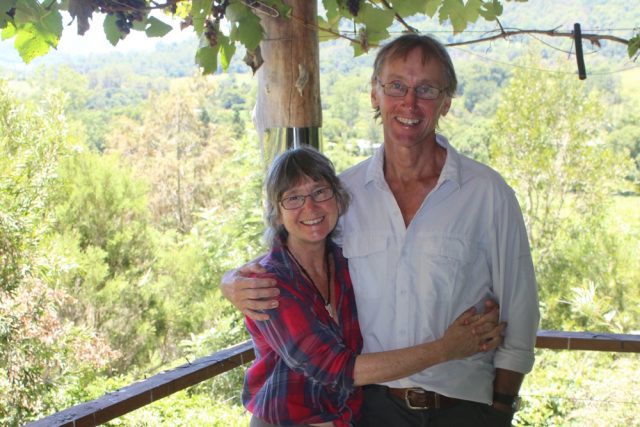
Isolation Psychology: Due to their commitment to regenerating the property’s natural ecosystems (subtropical rainforest and eucalypt forests) they spend most of their time alone on the property. Leslie stated: “It is easy to become a hermit; we are so devoted to our Landcare work, so we stay on the property”. Tony added: “It is so easy to become socially isolated here; we love our lifestyle so much. When we feel that we are becoming too isolated, we become proactive in bird clubs and garden club visits. We also allow the community to visit us; some feel that we are strange in the way we live.” Leslie: “Others expect us to be devoid of all modern lifestyle whims like owning a TV! We don’t stick to a script, we do as we please, but we are not materialistic”.
The mud-n-straw brick majesty with a view to Cathedral Rock: The climate here is humid subtropical with wet season summer rains, where days above 35oc are not uncommon. The minimums in winter can fall below 0, but the days hover around the 22oc mark. Keeping it rustic like Grandma’s house: It was a four year build to complete this wonderful space. As soon as I entered the house I felt at home, in fact it felt like I had been here before. The interior’s cooler air on this 36oc day, and the delicious, sweeping views out to the mountains …wow! The floorplan is 9m by 18m. For the Coop’s agricultural land planning, Tony placed the farm plan on Google Maps. The house is made from mud bricks and straw bales. Tony completed a course in straw bale building. The materials were sourced from the property or at timber auctions. The interior posts are made from the property’s weedy, large camphor laurel trees (Chinese in origin). The beautiful thatched ceiling is made from their resident lomandra (native grasses). Each metre consists of 14 bunches! There is a tin roof overlaying the thatching with fibre-glass tinterlation, and the heat there is intense, yet the thatching keeps this heat out. It took a very long time to complete all the thatching, thus allowing the lomandra to regrow in time to again be harvested. The clay for the bricks also came from the property. They also made homemade concrete to mix (render) with the clay in the wet areas of the house, such as solid fixtures in the kitchen area. The mud floors are made from clay/sand and finished with linseed oil- just like the old English flagstone floors. Tony: “We wanted a Rayburn oven-cooker, just like my gran’s. It was very expensive but Leslie uses it to bake bread, pizzas and quiches. We also crank it over in the humid summer months to prevent any mouldy growths from forming. It gives the air a fine quality when we do this”.
Outside, the toilet nestles on a wooden terrace with a view out into the exotic regenerated rainforest, with its Bangalow and Livistona palms. The grey waste is filtered through a reed-bed grey water filter. Initially, the reeds cracked the pipes open and all the water escaped before completing its cycle. The local council also benefitted from this information as they had recommended the pipe layout and type.
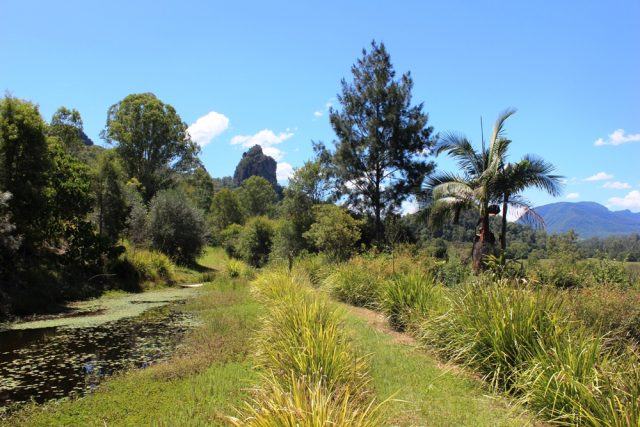
It was a learning process for Tony and Leslie as they watched this house grow. They had wanted to do this for a long time. The inspiration behind the house design came from a house in the Atherton Tablelands (tropical Far North Qld). Only eight solar panels are needed to power the house and pumps, churning out 1040 watts of power in total. Leslie: “While working for the Lismore Council, I kept an ear out for any available recyclables I could use for the house. If we built on freehold land we could never have afforded to do what we have done here. It was the only way we could opt out of the 9 to 5! There are no power bills, we have a low carbon footprint, and there are no personal rates either!”
The Garden & Surrounds: Well, where do we start? The diversity within the regeneration project has been incredible. I was once a rainforest regenerator myself, and I have a background in horticulture and tropical ecology. Trust me, the work they have achieved here is of a high quality, where the habitat is rich in floral diversity. It must be cherished by the abundant wildlife living with Tony and Leslie. Their gorgeous wallabies and resident Torresian crow, enjoy spending time alongside these nature lovers. Amongst the luxuriant jungle foliage, tropical fruit trees find space, along with the chillout chairs springing up here and there as you wander along the naturally constructed wallaby trails, weaving their way along the forest floor. Native rainforest plums also flourish here under the shade of the canopy. There are 40 different tropical and English fruit trees existing on the property, from bananas, mangoes and avocado – to the cooler climate apples and pears etc. There is a grove of 40 olive trees, planted out to produce olive oil. The permaculture- designed veggie and herb gardens are both creative and productive.
Needless to say, I enjoyed my day with Tony and Leslie Trott in their paradise that they have worked endlessly to provide as a benchmark in sustainability within the beautiful Nimbin surrounds.
